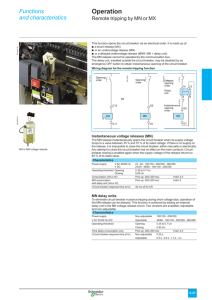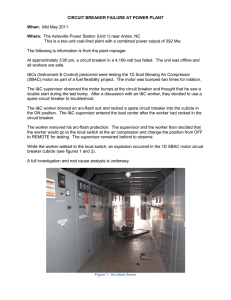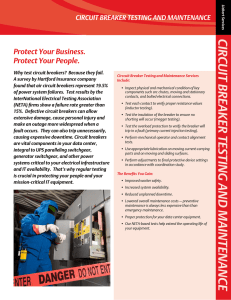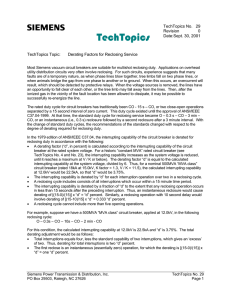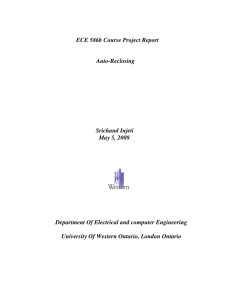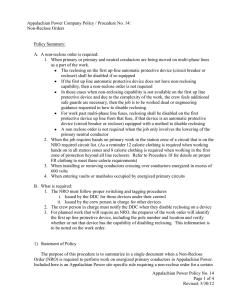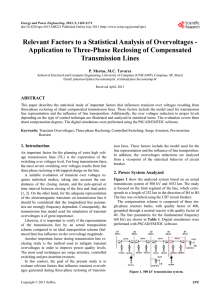TechTopics No. 05 Reclosing applications - minimum reclosing time www.usa.siemens.com/techtopics
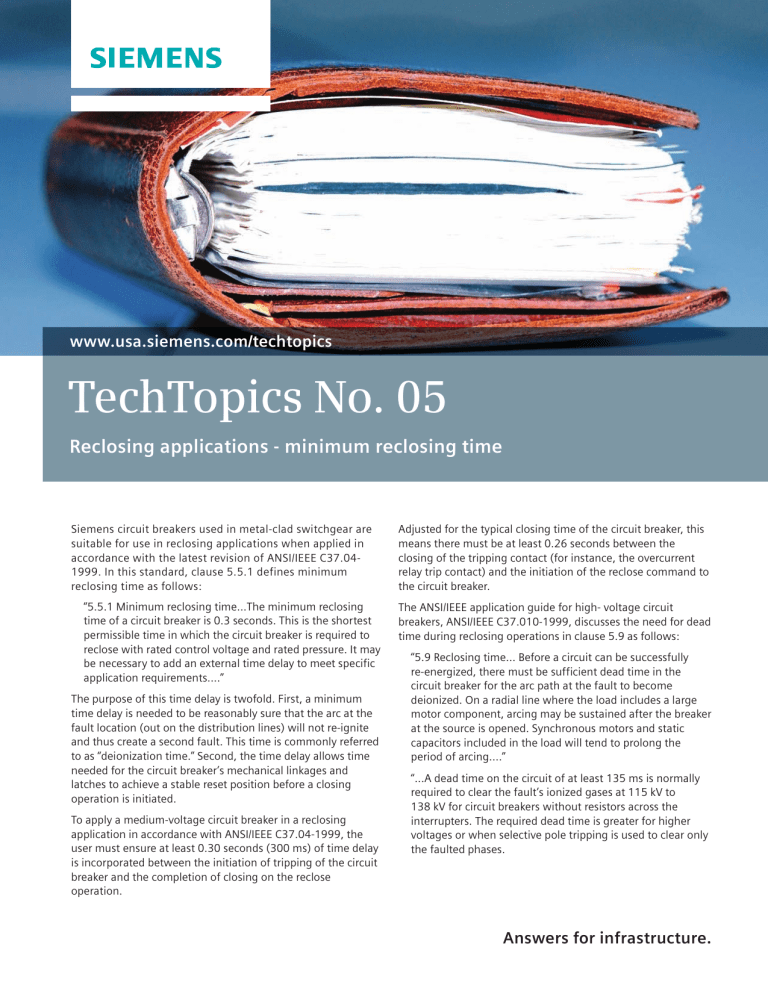
www.usa.siemens.com/techtopics
TechTopics No. 05
Reclosing applications - minimum reclosing time
Siemens circuit breakers used in metal-clad switchgear are suitable for use in reclosing applications when applied in accordance with the latest revision of ANSI/IEEE C37.04-
1999. In this standard, clause 5.5.1 defines minimum reclosing time as follows:
“5.5.1 Minimum reclosing time...The minimum reclosing time of a circuit breaker is 0.3 seconds. This is the shortest permissible time in which the circuit breaker is required to reclose with rated control voltage and rated pressure. It may be necessary to add an external time delay to meet specific application requirements....”
The purpose of this time delay is twofold. First, a minimum time delay is needed to be reasonably sure that the arc at the fault location (out on the distribution lines) will not re-ignite and thus create a second fault. This time is commonly referred to as “deionization time.” Second, the time delay allows time needed for the circuit breaker’s mechanical linkages and latches to achieve a stable reset position before a closing operation is initiated.
To apply a medium-voltage circuit breaker in a reclosing application in accordance with ANSI/IEEE C37.04-1999, the user must ensure at least 0.30 seconds (300 ms) of time delay is incorporated between the initiation of tripping of the circuit breaker and the completion of closing on the reclose operation.
Adjusted for the typical closing time of the circuit breaker, this means there must be at least 0.26 seconds between the closing of the tripping contact (for instance, the overcurrent relay trip contact) and the initiation of the reclose command to the circuit breaker.
The ANSI/IEEE application guide for high- voltage circuit breakers, ANSI/IEEE C37.010-1999, discusses the need for dead time during reclosing operations in clause 5.9 as follows:
“5.9 Reclosing time… Before a circuit can be successfully re-energized, there must be sufficient dead time in the circuit breaker for the arc path at the fault to become deionized. On a radial line where the load includes a large motor component, arcing may be sustained after the breaker at the source is opened. Synchronous motors and static capacitors included in the load will tend to prolong the period of arcing….”
“...A dead time on the circuit of at least 135 ms is normally required to clear the fault’s ionized gases at 115 kV to
138 kV for circuit breakers without resistors across the interrupters. The required dead time is greater for higher voltages or when selective pole tripping is used to clear only the faulted phases.
Answers for infrastructure.
Dead times on the order of several seconds may be required to allow secondary arcs to extinguish. (Secondary arcs result from capacitive coupling between the normal and faulted phases.)”
In accordance with ANSI/IEEE C37.04, it is the user’s responsibility to ensure that the required 0.30 second time delay is incorporated in the external control scheme. This time delay is not incorporated as an integral element of the circuit breaker mechanical design or electrical control circuitry.
It is recognized some users will wish to reclose with a time delay of less than 0.3 seconds (300 ms). As the time delay is decreased from 300 ms, the possibility increases that a reclose operation will fail due to excess ionization at the point of the fault.
Sources vary in the estimates of the amount of time that must be allowed between interruption of the fault and the subsequent re-energization. Most of the sources indicate there must be at least six cycles between arc interruption (on opening) and contact make on the subsequent closing operation.
When consideration is given to extremes of circuit breaker arcing time and closing time, we conclude that the reclosing relay should be set to issue a reclose command no sooner than six cycles (100 ms) after the “b” switch makes during an opening operation.
If the reclosing relay does not monitor the “b” switch to determine that the circuit breaker is open before it issues the close command, then the reclosing relay should be set to issue the reclose command no sooner than ten cycles (167 ms) after the opening signal is issued.
The need for a minimum time delay on instantaneous reclosing was less clear in earlier versions of the standards. Because of this, it is reasonable to assume some initial reclose operations have failed in practice because the air at the point of the fault had not deionized, and the fault re-ignited when the circuit breaker reclosed.
All Siemens vacuum circuit breakers (including types GMSG,
38-3AH3, SDV6 and GMI) are suitable for reclosing operations when the reclosing system allows at least six cycles (100 ms) between “b” switch closing and the initiation of the close command.
The information provided in this document contains merely general descriptions or characteristics of performance which in case of actual use do not always apply as described or which may change as a result of further development of the products. An obligation to provide the respective characteristics shall only exist if expressly agreed in the terms of contract.
All product designations may be trademarks or product names of
Siemens AG or supplier companies whose use by third parties for their own purposes could violate the rights of the owners.
Siemens Industry, Inc.
7000 Siemens Road
Wendell, NC 27591
Subject to change without prior notice.
Order No.: E50001-F710-A158-X-4A00
All rights reserved.
© 2012 Siemens Industry, Inc.
For more information, contact: +1 (800) 347-6659 www.usa.siemens.com/techtopics



